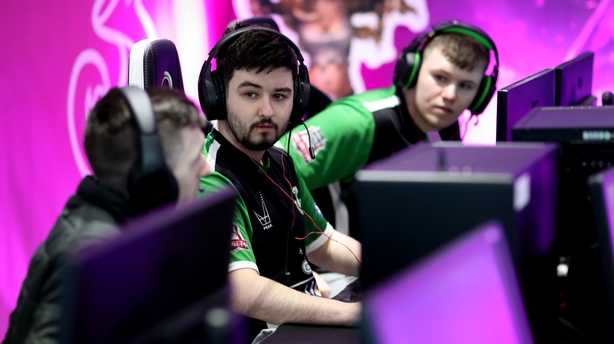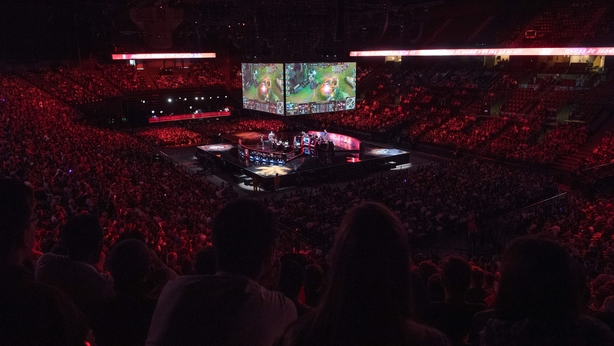Shamrock Rovers claimed an important 1-0 victory over Limerick at Tallaght Stadium last Wednesday.
It was a result that keeps Rovers at the top of the league table and very much on track for a semi-final place as the season draws to a climax.
So while Rovers’ soccer team and their manager Stephen Bradley are going through their share of struggles on the pitch at the moment, their eSports team are flying.
Rovers are one of nine SSE Airtricity Premier Division teams to field a side in Three Ireland’s EStars tournament, which has been running since the middle of March and will culminate in a grand final at the 3 Arena on 13 May with the winning team walking away with a cheque for €20,000 and a trip to Las Vegas.
Organised by First For E Players, a new company focused on live eSports in Ireland, the Estars tournament sees teams competing in League of Legends, a five-on-five action videogame that’s focused around territory control and heavy on both action and strategy.
At a basic level each team has a base that they are defending from the opposition team. Games take place in an overhead viewed map with various obstacles and hazards, with both sides trying to destroy the other’s base while defending their own.
It’s a formula and a game that has proven to be wildly popular with 27 million people playing League of Legends daily and developers Riot Games, who have a considerable presence in Dublin, boasting last year that they now have 100 million people playing their game monthly.
With such a massive worldwide user base, it’s little wonder that a major competitive scene has grown around the game and with that, the viewing audience has grown too. Live attendees to major tournaments regularly top the 100,000 mark and records for online audiences are constantly being broken.
In just three years, the biggest online unique viewers numbers for a live event have more than doubled. The 2014 International attracted an audience of 20 million but that was dwarfed by the 46million people who watched last year’s Intel Extreme Masters event in Poland.
And while the €20,000 on offer for the Estars event may seem impressive and is the largest prize that has been put up for an Irish tournament, it’s still small fry stuff in comparison to global competitions.
League of Legends, like its main competitor DOTA 2, supports a thriving and growing professional scene with tournament prize funds that regularly reach into and past the $3million range, with 2017’s ‘The International’ offering a massive $24,687,919, with the tournament winners taking home $10,862,683.
The audience is there, the money is there and all of a sudden people from outside the scene are sitting up and taking notice.
The biggest sign yet that eSports are being taken seriously by those from outside that sphere came last year when the International Olympic Committee (IOC) came out and not only declared that eSports are in fact, a sport, but announced that they would begin covering them on their Olympic Channel.
The issue of eSports was a heavy focus at at the pre-Winter Olympics summit and the IOC took the first tentative steps towards recognising the phenomenon and attempting to bring it within the Olympic fold.
A statement from the IOC at the time agreed that "eSports are showing strong growth, especially within the youth demographic across different countries, and can provide a platform for engagement with the Olympic Movement.
"Competitive eSports could be considered as a sporting activity, and the players involved prepare and train with an intensity which may be comparable to athletes in traditional sports.
"In order to be recognised by the IOC as a sport, the content of "eSports" must not infringe on the Olympic values. A further requirement for recognition by the IOC must be the existence of an organisation guaranteeing compliance with the rules and regulations of the Olympic Movement (anti-doping, betting, manipulation, etc.)."
While such official recognition has been broadly welcomed there remains a whiff of suspicion as to the OCI’s motives, particularly when they make such a point of coveting the youth demographic that has flocked to eSports. The same demographic that events like the Olympics are rapidly losing.

Nikita Buffee of ELC Gaming and match commentator for Estars is unconvinced by the need to align eSports alongside traditional sports and is wary of compromises that could be forced upon existing competitions in order to satisfy the IOC.
"You don’t need to define it," he told RTÉ Sport. "I don’t want it to be part of the Olympics because of what the IOC are hoping to achieve and the audience they’re trying to appeal to.
"Trying to force eSports into the category of sports has drawbacks and you’ve got to accept it for what it is and then you can combine them together.
"You wouldn’t force a football format onto rugby or cricket and vice-versa. So why are we looking at eSports and the plethora of games within it, and their unique identities and styles and then trying to homogenise them and fit them into this little box of sports? I don’t think that’s the way to go about it.
"These kids are obviously professionals and that’s what matters to me, not ‘are they sportsmen?’, but ‘are they professionals?’ Without a doubt they are. They’re at the top of their game, they’re competing against each other for fans and earning a salary, that’s a pro’ to me."
The demands placed upon professional eSport players are often just as intense as those in more traditional sports.
While professionals at the biggest teams can command a base salary of $350,000, before prize money is factored in, they have to work extremely hard for it. Teams will often live together in the same house and practice for 12 hours a day in the build up to major tournaments.
It’s a cut-throat business as well. Players can be ruthlessly cut from teams as soon as there’s a drop in performance and by and large a professional gamer's career is over and done with by the mid-20s when quick twitch reflexes begin to slow down.
Burn out and injury are also major issues for competitors with wrist, arm and neck injuries the most common injuries, while issues associated with repetitive motions like carpal tunnel syndrome and tennis elbow are also a concern.
There’s always someone younger and quicker waiting in the wings and while coaching is sometimes an option for the top players upon retirement, for many they’re out of the professional scene long before their 30th birthday.

The collegiate system in America is helping to alleviate some of that pressure with more than 50 colleges and universities now offering full esports scholarships in the same way they would with basketball and American football, so that at least when their time in the gaming scene is done, they'll have a qualification to show for their efforts.
In Ireland the competitive scene remains a fledgling one and the League of Ireland branding of EStars is perhaps fitting, with the step up to the full-time professional teams of America, Europe and Asia being akin to the step up in soccer to the Champions League.
However Emmet McDonnell of the Bohemians team is encouraged by the support that the scene is beginning to attract in Ireland and believes that events like EStars will help it to grow and help the players to develop.
"The League of Legends professional teams are a lot harder to break into than most people would think," he told RTÉ Sport.
"I don’t think there’s any Irish players in the major Riot sponsored events that I know of, so it’s harder for us, but we do have good players and if tournaments like this keep coming to Ireland and people are playing in them then we’ll improve all the time.
"I just think that they’re obviously a lot more skilled, not to say that we don’t have skills but they’re on a whole other level.
"You have to commit a lot of time to get to that level which not a lot of people have, but if we keep getting tournaments like this, then hopefully over time our skills will improve."
Those skills will be on display at Limerick UL on Wednesday and at DCU next Monday as the EStars league draws ever closer to that grand final at the 3 Arena in May.


